
An easy breakdown of the parts of a quantum computer and how they function.
- Subject:
- Computer Science
- Physics
- Science
- Material Type:
- Diagram/Illustration
- Provider:
- Fermi National Lab
- Author:
- Fermi National Lab
- Date Added:
- 11/08/2024

An easy breakdown of the parts of a quantum computer and how they function.

A visual representation of quantum deoherence
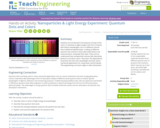
Students are introduced to the physical concept of the colors of rainbows as light energy in the form of waves with distinct wavelengths, but in a different manner than traditional kaleidoscopes. Looking at different quantum dot solutions, they make observations and measurements, and graph their data. They come to understand how nanoparticles interact with absorbing photons to produce colors. They learn the dependence of particle size and color wavelength and learn about real-world applications for using these colorful liquids.

A visual representation of quantum entanglement

A visual representation of how quantum computers work
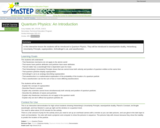
Introduction to Quantum Physics concepts with an activity demonstrating Heisenberg's Uncertainty Principle, wave/particle duality, Planck's Constant, de Broglie wavelength, and how Newton's Laws go right out the window on a quantum level.

A visual of how quantum sensors are being used to try to detect the existence of dark matter

A visual representation of how particles can spin in opposite directions at the same time

A visual of how quantum teleportation works
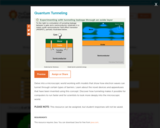
Delve into a microscopic world working with models that show how electron waves can tunnel through certain types of barriers. Learn about the novel devices and apparatuses that have been invented using this concept. Discover how tunneling makes it possible for computers to run faster and for scientists to look more deeply into the microscopic world.

In classical physics, objects have precise position and waves are spread out in space. In the quantum world, these two concepts are combined. It is impossible to measure the precise position and velocity of and particle simultaneously.
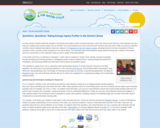
This article from Beyond Weather and the Water Cycle provides ideas on how school librarians can work with elementary teachers to teach about the Sun's impact on weather and climate. The author introduces the Standards for the 21st Century Learner, developed by the American Association of School Librarians. The author focuses on Standard 1, which calls for students to inquire, think critically, and gain knowledge through developing and refining questions, investigating answers, seeking divergent perspectives in information, and assessing whether the information found answers the questions posed. The free, online magazine draws its themes from the Seven Essential Principles of Climate Literacy, with each issue focusing on one of the seven principles.

In this video from Cyberchase, the CyberSquad figures out how fast their broom must go so they can reach Motherboard before Wicked.
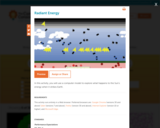
How does energy flow in and out of our atmosphere? Explore how solar and infrared radiation enters and exits the atmosphere with an interactive model. Control the amounts of carbon dioxide and clouds present in the model and learn how these factors can influence global temperature. Record results using snapshots of the model in the virtual lab notebook where you can annotate your observations.

In this activity, participants will investigate radio waves—one type of energy from the electromagnetic spectrum. While radio waves are invisible, we can interact with them through interference. Participants will experiment with both non-conductive and conductive materials to determine which is best at blocking radio waves, while discovering differences in the radio waves used by a range of devices including: portable radios, walkie-talkies, and/or Bluetooth speakers. Because different devices use different radio frequencies, some radio waves will travel better through certain materials. Educators should begin with the file named: Radio Silence - Lesson Plan - START HERE.
Estimated time required: 1-2 class periods.
Technology required for this lesson: Tablet or Smartphone.

In this activity, learners will experiment with different materials to interact with the radio waves coming from a household Wi-Fi router. Participants will be challenged to both decrease and increase Wi-Fi signal strength through the choice and position of materials. Through use of a mobile app to track Wi-Fi signal strength, participants will explore the concepts of reflection, absorption, and transmission of radio waveswithin the experimental setup. An optional extension to this activity will introduce the concept of polarization of radio waves and allow participants to observe differences in dual-band Wi-Fi router signals. Educators should begin with the file named: W-Fi Detective - Lesson Plan - START HERE.
Estimated time required: 1-2 class periods.
Technology required for this lesson: Smartphone.
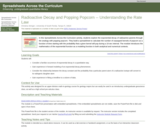
Spreadsheets Across the Curriculum module. Students build spreadsheets to forward model an example of exponential decay and interpret the meaning of the decay constant.
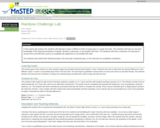
In this inquiry lab activity, the students will attempt to layer 6 different kinds of soda pops in a large test tube. The students will have to use prior knowledge of the physical properties of liquids, in particular density, to accomplish this task.
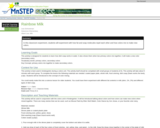
In this classroom experiment the students will observe primary colors mixing together to create a secondary color.
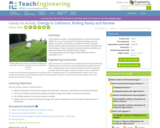
In this hands-on activity rolling a ball down an incline and having it collide into a cup the concepts of mechanical energy, work and power, momentum, and friction are all demonstrated. During the activity, students take measurements and use equations that describe these energy of motion concepts to calculate unknown variables, and review the relationships between these concepts.